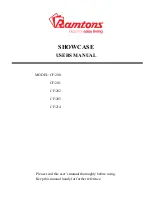
1-3
Stormscope
®
WX-1000 Pilot’s Guide
3-3
Chapter 3 – Operation
Discharge Points
The position of these +
symbols indicates the azimuth and range of the
detected electrical discharge activity relative to your
aircraft. Discharge points sometimes overlap to
form clusters. A large cluster indicates that the
thunderstorm covers a large area. A dense cluster
indicates an intense thunderstorm. The size of the
discharge points increases as the selected range
decreases in order to enhance the storm clustering
effect on the shorter ranges. The latest discharge
points (none older than
2
minutes) are stored in memory
and displayed even if you switch ranges or views and
then switch back to the original range or view.
Azimuth Markers
The azimuth markers
help to quantify the angular location of electri-
cal discharges relative to the aircraft. In the
360
°
view,
9
short radial markers are spaced
30
°
apart around the outside of the outer range
ring. In the
120
° view,
4
azimuth markers
radiate out from the aircraft symbol at
30
°
and
60
° on either side of the aircraft heading.
Turn On the WX-1000
1. Rotate the OFF/BRT knob clockwise about 180°.
The switch clicks and the
WX-1000
begins the power-up
self test and displays the
SELF-TEST
screen (figure
3-2
)
with the message
SYSTEM TEST IN
PROGRESS
. The
power-up self test
takes about
15
seconds to ensure
that all major
functions are operat-
ing properly. Items
tested include
antenna reception,
memory, micropro-
cessor functions, and
installed options.
+++
+++
+
+++
++++
++
+
+
+++
+++
+
Turn On the WX-1000
S E L F - T E S T
W X - 1 0 0 0
S Y S T E M
T E S T
I N
P R O G R E S S
.
.
.
BRT
OFF
Figure 3-2. System Test in Progress



































